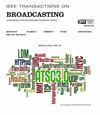Environment Information Enhanced Neural Adaptive Bitrate Video Streaming for Intercity Railway
IF 4.8
1区 计算机科学
Q2 ENGINEERING, ELECTRICAL & ELECTRONIC
引用次数: 0
Abstract
Intercity railways are vital to modern transportation systems, providing high-speed and efficient connections between cities. With the increasing demand for onboard entertainment and real-time monitoring systems, ensuring high Quality of Experience (QoE) video transmission has become a critical challenge. The unique characteristics of intercity railways, such as predictable railway schedules, spatial routes, and passenger-induced tidal effects, offer significant opportunities for optimizing video transmission performance. However, existing video streaming solutions must fully leverage these characteristics, resulting in inefficient bandwidth utilization, unstable video quality, and frequent interruptions caused by rapid train velocity, frequent handovers, and fluctuating network loads. This paper proposes an Environmental Information Enhanced adaptive video streaming (EIE-ABR) scheme that integrates environmental information with advanced techniques to address these challenges. Firstly, the scheme employs Deep Reinforcement Learning (DRL) to model the dynamic relationship between train speed and base station distance, enabling proactive bitrate adjustments in response to fluctuating network conditions. Secondly, EIE-ABR uses seasonal trend decomposition (STL) to capture throughput variations driven by periodic patterns, such as railway schedules and tidal effects, as well as abrupt disruptions from handovers or link failures. By combining DRL with STL, EIE-ABR achieves accurate throughput prediction and adapts effectively to the highly dynamic intercity railway environment. Simulation results show that EIE-ABR outperforms existing ABR algorithms, achieving an 11.22% improvement in average QoE reward.城际铁路环境信息增强神经自适应比特率视频流
城际铁路对现代交通系统至关重要,它提供了城市之间高速高效的连接。随着车载娱乐和实时监控系统需求的增加,确保高体验质量(QoE)视频传输已成为一项关键挑战。城际铁路的独特特点,如可预测的铁路时刻表、空间路线和乘客引起的潮汐效应,为优化视频传输性能提供了重要的机会。然而,现有的视频流解决方案必须充分利用这些特性,导致带宽利用率低下,视频质量不稳定,并且由于列车速度快、切换频繁和网络负载波动而频繁中断。本文提出了一种环境信息增强自适应视频流(EIE-ABR)方案,该方案将环境信息与先进技术相结合,以解决这些挑战。首先,该方案采用深度强化学习(Deep Reinforcement Learning, DRL)对列车速度和基站距离之间的动态关系进行建模,能够主动调整比特率以应对波动的网络状况。其次,EIE-ABR使用季节性趋势分解(STL)来捕获由周期性模式驱动的吞吐量变化,例如铁路时刻表和潮汐效应,以及移交或链路故障造成的突然中断。通过将DRL与STL相结合,EIE-ABR实现了准确的吞吐量预测,有效地适应了高度动态的城际铁路环境。仿真结果表明,EIE-ABR算法优于现有的ABR算法,平均QoE奖励提高11.22%。
本文章由计算机程序翻译,如有差异,请以英文原文为准。
求助全文
约1分钟内获得全文
求助全文
来源期刊

IEEE Transactions on Broadcasting
工程技术-电信学
CiteScore
9.40
自引率
31.10%
发文量
79
审稿时长
6-12 weeks
期刊介绍:
The Society’s Field of Interest is “Devices, equipment, techniques and systems related to broadcast technology, including the production, distribution, transmission, and propagation aspects.” In addition to this formal FOI statement, which is used to provide guidance to the Publications Committee in the selection of content, the AdCom has further resolved that “broadcast systems includes all aspects of transmission, propagation, and reception.”
 求助内容:
求助内容: 应助结果提醒方式:
应助结果提醒方式:


